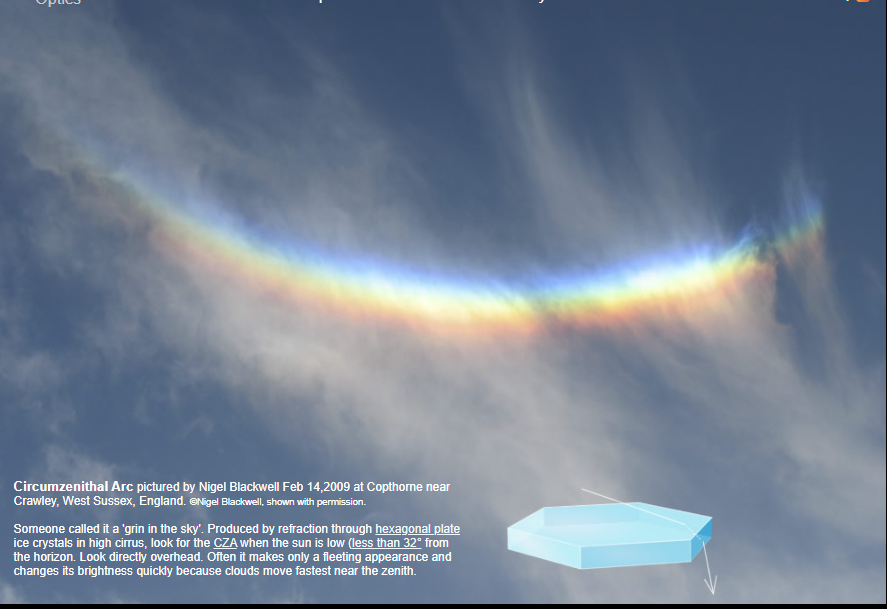Sussex Circumzenithal Arc
Sussex Circumzenithal Arc: A Stunning Atmospheric Phenomenon
Have you ever looked up at the sky and been captivated by a mysterious and enchanting optical display? One such phenomenon that has left many in awe is the Sussex Circumzenithal Arc (CZA). Often referred to as a "grin in the sky," this breathtaking atmospheric optical phenomenon occurs when sunlight passes through hexagonal plate ice crystals in high cirrus clouds. In this article, we will delve into the intricacies of the Sussex Circumzenithal Arc, exploring its formation, appearance, and the factors that contribute to its fleeting nature.
Formation of the Sussex Circumzenithal Arc
The Sussex Circumzenithal Arc is formed through a process called refraction. When sunlight encounters hexagonal plate ice crystals in high cirrus clouds, the light is bent as it passes through these crystals. This bending of light creates a stunning display of colors that form an arc in the sky, with the arc's center located directly overhead.
Appearance and Characteristics
To catch a glimpse of the Sussex Circumzenithal Arc, one must look towards the zenith when the sun is low, at an angle of less than 32 degrees from the horizon. This optical phenomenon often appears fleetingly, making its presence known for only a short period of time. The brightness of the CZA can vary rapidly, as clouds tend to move fastest near the zenith.
When the conditions are just right, the Sussex Circumzenithal Arc presents itself as a vibrant and vivid display of colors. The arc appears as an upside-down rainbow, with its colors arranged in reverse order compared to a traditional rainbow. The inner edge of the arc is red, followed by orange, yellow, green, and blue on the outer edge.
Factors Influencing the Appearance of the Sussex Circumzenithal Arc
Several factors contribute to the appearance and visibility of the Sussex Circumzenithal Arc. These include:
-
Presence of High Cirrus Clouds: The formation of the CZA relies on the presence of high cirrus clouds, which consist of thin, wispy ice crystals. Without these clouds, the optical phenomenon cannot occur.
-
Sun Angle: The angle at which the sun is positioned in relation to the observer plays a crucial role in the visibility of the Sussex Circumzenithal Arc. When the sun is lower in the sky, the light passes through a greater portion of the ice crystals, enhancing the chances of witnessing this ethereal display.
-
Crystal Orientation: The orientation of the hexagonal plate ice crystals also affects the appearance of the CZA. For the arc to form, the crystals must be aligned horizontally, allowing sunlight to pass through them at a specific angle.
-
Atmospheric Conditions: Atmospheric conditions such as temperature and humidity can impact the formation and visibility of the Sussex Circumzenithal Arc. These factors influence the size and shape of ice crystals, which ultimately determine the optical effects produced.
Similar Atmospheric Optical Phenomena
The Sussex Circumzenithal Arc belongs to a family of atmospheric optical phenomena known as halos. Halos are formed when light interacts with ice crystals in the atmosphere, resulting in various mesmerizing displays. Some other notable halos include:
-
22-Degree Halo: This circular halo appears as a ring around the sun or moon and is caused by the refraction of light through hexagonal ice crystals.
-
Sun Dogs: Sun dogs are bright spots that appear on either side of the sun, often accompanied by a halo. They are caused by the refraction of sunlight through ice crystals in the atmosphere.
-
Supralateral Arc: Similar to the CZA, the supralateral arc is an arc-shaped halo that forms above the sun. It is caused by the refraction of light through horizontally oriented ice crystals.
Capturing the Magic: Photographing the Sussex Circumzenithal Arc
If you are fortunate enough to witness the Sussex Circumzenithal Arc, capturing its beauty through photography can be a rewarding experience. To photograph this optical phenomenon:
- Use a wide-angle lens to capture as much of the sky as possible.
- Adjust your camera settings to ensure proper exposure and focus.
- Consider including a landmark or an interesting foreground element to enhance the composition of your photograph.
- Experiment with different angles and perspectives to capture the full extent of the arc's vibrant colors.
Remember, patience is key when photographing atmospheric optical phenomena. The appearance of the Sussex Circumzenithal Arc is unpredictable, and it may take multiple attempts before you can capture its ephemeral beauty.
The Sussex Circumzenithal Arc: A Celestial Delight
The Sussex Circumzenithal Arc is undoubtedly a celestial delight that has left many in awe of its enchanting beauty. Its formation through the refraction of sunlight through hexagonal plate ice crystals in high cirrus clouds creates a mesmerizing display of colors that graces the sky for a brief moment. So, next time you find yourself gazing at the heavens, keep an eye out for this elusive "grin in the sky" and let yourself be captivated by its ethereal charm.

Circumzenithal Arc pictured by Nigel Blackwell Feb 14,2009 at Copthorne near Crawley, West Sussex, England. ©Nigel Blackwell, shown with permission.
Someone called it a 'grin in the sky'. Produced by refraction through hexagonal plate ice crystals in high cirrus, look for the CZA when the sun is low (less than 32° from the horizon. Look directly overhead. Often it makes only a fleeting appearance and changes its brightness quickly because clouds move fastest near the zenith.
Note: this article has been automatically converted from the old site and may not appear as intended. You can find the original article here.
Reference Atmospheric Optics
If you use any of the definitions, information, or data presented on Atmospheric Optics, please copy the link or reference below to properly credit us as the reference source. Thank you!
-
<a href="https://atoptics.co.uk/blog/sussex-circumzenithal-arc/">Sussex Circumzenithal Arc</a>
-
"Sussex Circumzenithal Arc". Atmospheric Optics. Accessed on November 22, 2024. https://atoptics.co.uk/blog/sussex-circumzenithal-arc/.
-
"Sussex Circumzenithal Arc". Atmospheric Optics, https://atoptics.co.uk/blog/sussex-circumzenithal-arc/. Accessed 22 November, 2024
-
Sussex Circumzenithal Arc. Atmospheric Optics. Retrieved from https://atoptics.co.uk/blog/sussex-circumzenithal-arc/.